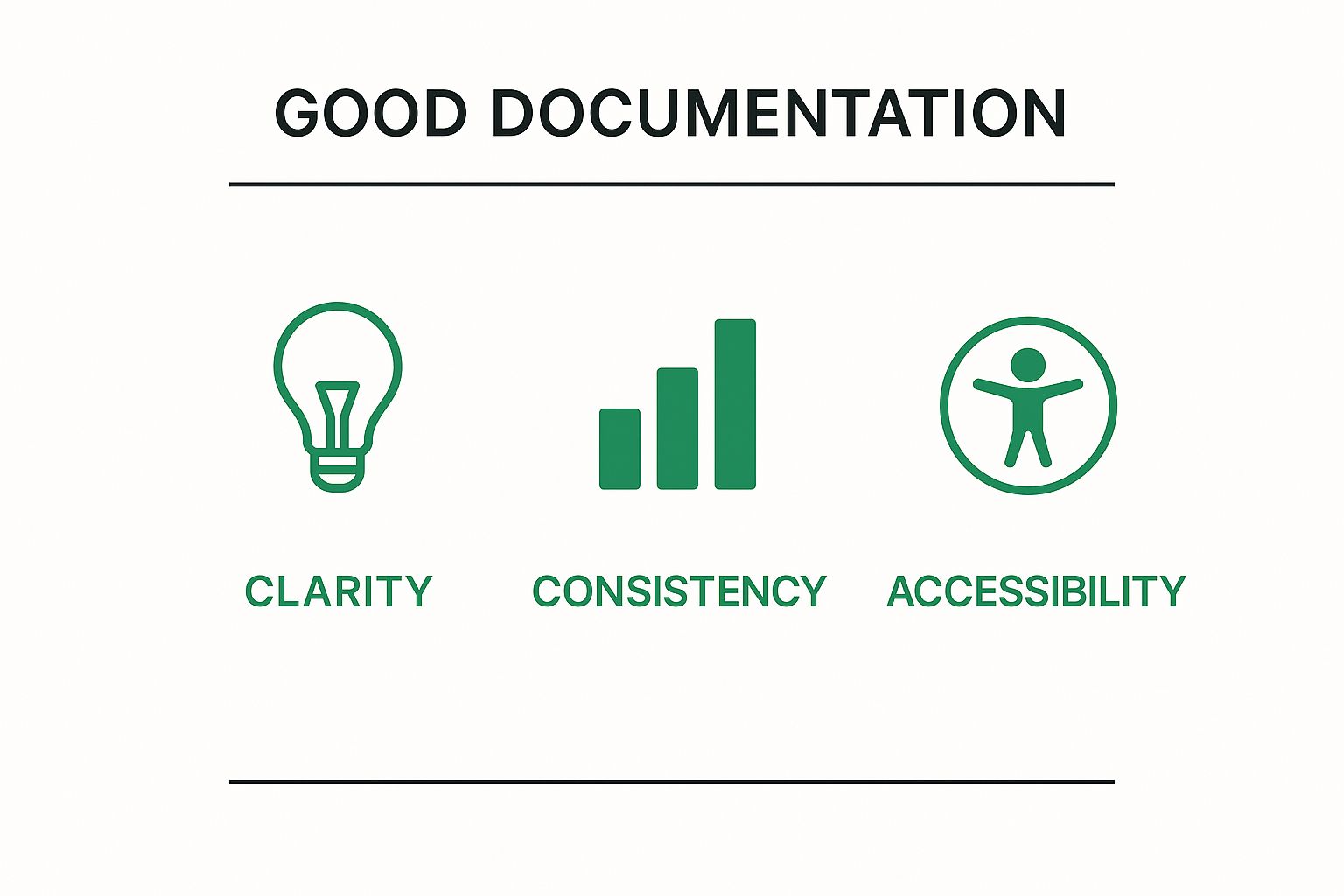Learn how proper documentation standards boost compliance and streamline operations. Discover proven strategies used by industry leaders.

Inconsistent documentation can have a significant impact on your business’s bottom line. This goes beyond simply having disorganized files; it translates into real costs and missed opportunities. Establishing proper documentation standards creates organizational clarity, which offers numerous benefits across different departments.
This improved clarity leads to tangible advantages, making it a key focus for successful organizations. For instance, standardized documentation improves knowledge transfer. When information is presented consistently, new employees onboard faster, and current staff can readily access needed information.
This reduces training time and increases overall productivity. Furthermore, standardized documentation significantly reduces errors. Clear, concise, and accessible information minimizes misunderstandings and ensures everyone operates from the same set of guidelines.
The advantages of strong documentation extend further. Robust documentation standards enhance operational resilience. During unexpected disruptions or staff turnover, well-maintained documentation ensures business continuity.
This means crucial processes can continue without interruption, protecting operations and minimizing potential losses. It also allows for scalable growth. With clear documentation, expanding operations or integrating new teams becomes a smoother process.
Moreover, strong documentation standards preserve critical institutional knowledge. This protects valuable insights and best practices, preventing their loss due to employee departures or shifting priorities. Unfortunately, many organizations overlook the hidden costs of poor documentation.
These costs can include wasted time searching for information, expensive errors stemming from miscommunication, and compliance issues arising from incomplete records. The transition to digital documentation is increasingly crucial for efficiency and accuracy. A surprising 97% of organizations reportedly had minimal or no digital document processes in place.
This lack of digital documentation standards contributes to inefficiencies costing businesses over $600 billion annually due to data entry errors. Implementing robust digital documentation standards can mitigate these costs and enhance data accuracy. More detailed statistics are available here: Learn more about documentation statistics. These factors greatly affect a business’s overall success and profitability.
By prioritizing and implementing solid documentation standards, businesses can avoid these issues and reach their full potential.
Different industries face unique documentation challenges. Generic approaches often fall short. This section explores how specific sectors, like healthcare, software development, manufacturing, legal, and finance, have developed tailored documentation standards. These standards address the specific operational and compliance needs of each field. Understanding these specialized approaches provides valuable insights into effective documentation strategies.
The healthcare industry prioritizes accuracy and patient safety. Documentation standards like HL7 (Health Level Seven International) facilitate the exchange of clinical and administrative data between different healthcare systems. This interoperability is crucial for coordinated care and informed decision-making. Additionally, adherence to standards like DICOM (Digital Imaging and Communications in Medicine) ensures the secure and reliable exchange of medical images.
Software development documentation must be agile and collaborative. Standards like the IEEE documentation standards (Institute of Electrical and Electronics Engineers) provide frameworks for software requirements specifications, design documents, and test plans. Consistent code documentation practices are essential for maintaining code quality and facilitating collaboration among developers. This helps ensure software projects remain on track, are easily maintainable, and meet quality standards. For more in-depth information, check out this guide on code documentation best practices. You might also find this resource helpful: How to master code documentation best practices.
Manufacturing relies heavily on documentation for traceability and quality control. Standards like ISO 9001 (International Organization for Standardization) emphasize documented procedures for quality management systems. These procedures ensure products meet stringent quality requirements. This detailed documentation allows manufacturers to track products throughout their lifecycle, identify potential issues, and maintain high standards of quality and safety.

This infographic contrasts crucial elements of effective documentation: clarity, consistency, and accessibility. The visualization highlights the importance of balancing these three elements. Each contributes equally to the overall quality and usability of the information. For specific examples and templates, refer to a Project Documentation Template Guide.
Legal and financial industries must comply with strict regulations. Documentation standards ensure compliance and mitigate risk. Financial institutions adhere to standards set by regulatory bodies like the SEC (Securities and Exchange Commission). These standards dictate how financial information must be reported and documented to ensure transparency and accountability. Efforts to standardize documentation are evident in global health initiatives. The World Health Organization (WHO) released the 2025 update to the International Classification of Diseases (ICD-11), which improves interoperability and accuracy. Learn more about the ICD-11 update).
To further illustrate the variations in documentation standards across industries, let’s examine the following table:
Industry-Specific Documentation Standards Comparison: A comparison of major documentation standards across different industries, highlighting their key requirements, benefits, and implementation challenges.
This table highlights the diverse requirements and challenges associated with implementing documentation standards across different sectors. From the stringent demands of patient safety in healthcare to the need for agile documentation in software development, each industry necessitates a tailored approach. Understanding these nuances is critical for developing effective documentation strategies.

Effective documentation standards are more than just a set of guidelines. They’re essential tools that empower teams to maintain consistency and efficiency. But even the most comprehensive standards will fall short if they’re too complicated or don’t align with actual workflows. Focusing on implementation is just as important as the content itself.
Creating documentation standards that people will actually use requires a delicate balance of structure and usability. This involves using clear terminology, ensuring everyone can understand the documentation regardless of their technical expertise. Easy access to the information is also key, allowing individuals to quickly find what they need, when they need it.
Integrating metadata directly into your documentation standards makes searching and organization far more efficient. Documents can be tagged with relevant keywords, boosting their discoverability. For instance, a document about a particular software feature could be tagged with the feature name and related terms.
Robust version control, especially in collaborative settings, is also essential. Git allows teams to track changes, revert to previous versions, and guarantee everyone is working with the most up-to-date information. A clear understanding of how to write a product specification is vital for documenting product requirements.
Documentation standards should be seen as helpful resources, not cumbersome burdens. Involving stakeholders in the development process is crucial. Their input helps create standards that address real-world needs and challenges.
Training also plays a key role in successful adoption. Teams need to understand not only what the standards are, but also why and how they’re used. Training should emphasize the practical application of the standards and how they improve workflows. Providing easily accessible support and resources further ensures individuals can get the help they need during implementation.
Documentation standards should integrate seamlessly into existing workflows to avoid disruptions and encourage adoption. One effective strategy is incorporating documentation tasks into project management tools like Asana or Jira. For example, documentation reviews could become a standard step in project milestones.
This reinforces the importance of documentation and makes it a natural part of the process. Providing easy-to-use templates and tools simplifies the documentation process, reducing the perceived workload and making it easier for individuals to adhere to the standards.

Transitioning to new documentation standards can feel like a daunting task. But with a clear plan, the process can be surprisingly smooth and even efficient. This section provides a practical roadmap for implementing new standards, minimizing disruption and maximizing team adoption.
The first step is understanding your current documentation landscape. Where is existing documentation stored? Who uses it and how effective is it? This initial assessment provides a crucial baseline for developing tailored documentation standards. You might uncover redundant files, outdated information, or inconsistencies in formatting.
Getting stakeholder input is also essential. Talk to the people who actually use the documentation. Understanding their needs and challenges ensures the new standards are practical and relevant. This collaborative approach fosters buy-in and promotes smoother adoption across the organization. The result? Increased compliance and improved overall efficiency.
After assessing your current situation and gathering feedback, the next step is developing standards that reflect real-world needs. These standards should be clear, concise, and easy to understand. This clarity minimizes confusion and ensures consistent interpretation across teams.
Practical training is key to successful implementation. Provide teams with clear guidance on how to apply the new standards. Consider hands-on workshops, accessible documentation, and ongoing support to address any questions. This empowers teams to effectively use the new standards and contribute to a more consistent and efficient documentation process.
Introducing new documentation standards can sometimes meet resistance. This might be due to perceived increased workload or a lack of understanding of the benefits. Addressing these concerns directly is crucial. Sharing success stories from other organizations or demonstrating how the new standards will improve existing workflows can be highly effective.
Finally, a governance structure ensures your documentation standards stay relevant as your organization evolves. This structure provides a framework for ongoing review and updates, adapting to changing needs and best practices. This proactive approach keeps your documentation effective and useful over the long term. Consider a dedicated team responsible for maintaining and updating these standards.
The way we handle documentation is evolving. Instead of static files, organizations are building dynamic, accessible, and interconnected systems. This shift offers significant potential for increased efficiency and easier compliance, especially as businesses face growing complexity.
Automation is key to modernizing documentation. Tools like DocuWriter.ai automate code and API documentation, freeing developers from tedious manual work. DocuWriter.ai not only saves time and resources but also boosts accuracy and consistency. AI-powered tools can also analyze existing documentation, identifying gaps and areas for improvement. This further enhances quality and streamlines the entire documentation process. For more insights into best practices, check out this helpful resource: How to master documentation best practices.
Cloud platforms provide significant advantages for managing documentation. They offer centralized repositories accessible from anywhere, simplifying collaboration and version control. This approach eliminates the headaches of juggling multiple document versions scattered across various systems. Real-time updates and seamless sharing ensure everyone accesses the most current information.
While adopting new technologies, organizations must prioritize security. Cloud-based documentation systems need robust security measures to safeguard sensitive data. This includes access controls, encryption, and regular security audits. Finding the right balance between embracing innovation and maintaining strong security builds trust and ensures compliance.
Different documentation types require different solutions. Highly regulated industries, for example, might need specialized tools for audit trails and compliance reporting. Understanding your organization’s specific needs is crucial for selecting the right technology. Choosing tools that integrate with existing workflows also encourages adoption and minimizes disruption.
Before we discuss implementation, let’s look at the impact of these changes. The following table provides a statistical overview of how digital documentation improves key metrics.
Impact of Digital Transformation on Documentation Practices
This table shows how standardized digital documentation affects organizational efficiency, error rates, compliance, and cost savings compared to traditional methods.
As you can see, digital transformation leads to significant improvements across all metrics. From increased efficiency to substantial cost savings, the benefits of adopting standardized digital documentation are clear.
Transitioning to new documentation systems can be challenging. Resistance to change, integration complexities, and training needs are common obstacles. Open communication, thorough training, and phased implementation can help address these challenges. Starting with a pilot project to test new systems and gather feedback before full-scale deployment is highly recommended. Providing ongoing support and resources ensures a smoother transition. Initiatives like Germany’s promotion of ODF (Open Document Format) demonstrate a growing trend toward open, accessible, and interoperable documentation standards.
The world of documentation is constantly evolving. This section explores emerging trends that are shaping how organizations manage and use their documentation. From blockchain verification to AI-powered tools, these advancements offer exciting new possibilities for increased efficiency, better security, and stronger collaboration.
Blockchain technology provides a robust solution for verifying the authenticity and integrity of documents. By recording document hashes on a distributed ledger, blockchain prevents tampering and creates a permanent, unchangeable record of any alterations. This is especially important for legally sensitive documents like contracts and certifications. Imagine verifying a document’s authenticity with a quick scan of a QR code. This simplifies the process and significantly reduces the risk of fraud.
Artificial intelligence (AI) is rapidly changing how we approach documentation. AI-powered tools can automatically format documents, identify inconsistencies, and even generate content based on existing data. This real-time standardization drastically reduces manual work and ensures consistency across all documents. The increased efficiency frees up valuable time, allowing teams to focus on more strategic tasks. AI can also automatically tag documents with metadata, making information retrieval faster and more accurate.
Static documents are becoming a thing of the past, replaced by dynamic and interconnected systems. These systems use APIs and webhooks to integrate documentation with other business processes. For example, a change in a product’s code could automatically update the relevant documentation. This interconnectivity keeps information current and consistent across various platforms. Imagine sales materials that automatically reflect the latest product updates, eliminating the risk of outdated information.
Regulations are constantly changing, leading to new requirements for documentation standards. Initiatives like Germany’s focus on the Open Document Format (ODF) highlight a growing trend towards open, accessible, and interoperable documentation standards. Businesses need to stay informed about these changes to maintain compliance and stay competitive. Staying updated on evolving standards is about more than just compliance – it’s about positioning your organization for future success. By proactively adapting, organizations can maintain efficiency and avoid potential legal issues.
By embracing these trends and proactively adapting, organizations can thrive in the ever-changing world of documentation standards. Ready to transform your documentation process? Explore the power of AI-powered documentation with DocuWriter.ai. Learn more about DocuWriter.ai.